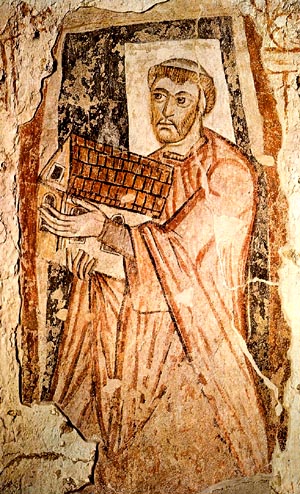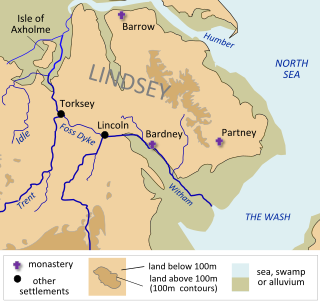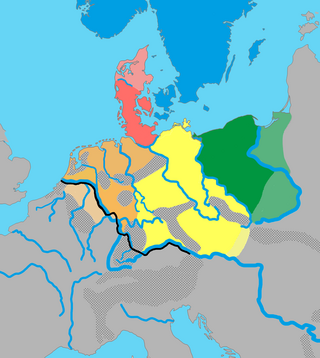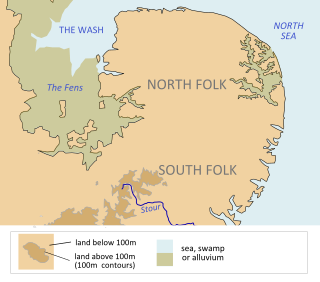
Benedict Biscop, also known as Biscop Baducing, was an Anglo-Saxon abbot and founder of Monkwearmouth-Jarrow Priory and was considered a saint after his death.

The Kingdom of Lindsey or Linnuis was a lesser Anglo-Saxon kingdom, which was absorbed into Northumbria in the 7th century. The name Lindsey derives from the Old English toponym Lindesege, meaning "Isle of Lind". Lindum Colonia was the Roman name of the settlement which is now the City of Lincoln in Lincolnshire. Lindum was a Latinised form of a native Brittonic name which has been reconstructed as *Lindon.

Creoda may have been one of the first kings of the Anglo-Saxon kingdom of Mercia, ruling toward the end of the 6th century.

The Ingaevones were a Germanic cultural group living in the Northern Germania along the North Sea coast in the areas of Jutland, Holstein, and Lower Saxony in classical antiquity. Tribes in this area included the Angles, Chauci, Saxons, and Jutes.
Tytila was a semi-historical pagan king of East Anglia, a small Anglo-Saxon kingdom which today includes the English counties of Norfolk and Suffolk. Early sources, including Bede's Ecclesiastical History of the English People, identify him as an early member of the Wuffingas dynasty who succeeded his father Wuffa. A later chronicle dates his reign from 578, but he is not known to have definitely ruled as king and nothing of his life is known. He is listed in a number of genealogical lists.
Various gods and men appear as sons of Odin in Old Norse and Old English texts.
Wecta is a figure mentioned in the Anglo-Saxon Chronicle and the Historia Brittonum.
In Germanic mythology, Seaxnēat or Saxnôt was the national god of the Saxons. He is sometimes identified with either Tīwaz or Fraujaz.

The Wuffingas, Uffingas or Wiffings were the ruling dynasty of East Anglia, the long-lived Anglo-Saxon kingdom which today includes the English counties of Norfolk and Suffolk. The Wuffingas took their name from Wuffa, an early East Anglian king. Nothing is known of the members of the dynasty before Rædwald, who ruled from about 599 to c.624. The Viking invasions of the 9th century and Dissolution of the monasteries in the 16th century both led to the destruction of documents relating to the rule of the Wuffingas.
Ealdwulf, also known as Aldulf or Adulf, was king of East Anglia from c. 664 to 713. He was the son of Hereswitha, a Northumbrian princess, and of Æthilric, whose brothers all ruled East Anglia during the 7th century. Ealdwulf recalled that when he was very young, he saw the Christian/pagan temple belonging to his ancestor Rædwald.

Eni or Ennius was a member of the Wuffing family, the ruling dynasty of the kingdom of East Anglia. He was the son of the semi-historical pagan king Tyttla and the brother of Rædwald, who both ruled East Anglia.

Wuffa is recorded in the Anglo-Saxon genealogies as an early king of East Anglia. If historical, he would have lived in the 6th century.
Creoda is a shadowy figure from early Wessex history whose existence is disputed.

The Anglian collection is a collection of Anglo-Saxon royal genealogies and regnal lists. These survive in four manuscripts; two of which now reside in the British Library. The remaining two belong to the libraries of Corpus Christi College, Cambridge and Rochester Cathedral, the latter now deposited with the Medway Archives.
The Prologue is the first section of four books of the Prose Edda, and consists of a euhemerized account of the origins of Norse mythology. According to the Prologue, the Norse gods originate from the Trojans described in Homer's poetry, and are King Priam's descendants. Priam's grandson Thor traveled throughout the world after leaving Thrace, fighting monsters and a dragon; he eventually came far north where he married a local named Sif. From them descended both the Norse gods as well as royal lines of various kingdoms.
A number of royal genealogies of the Anglo-Saxon kingdoms, collectively referred to as the Anglo-Saxon royal genealogies, have been preserved in a manuscript tradition based in the 8th to 10th centuries.
Langfeðgatal is an anonymous, twelfth-century Icelandic genealogy of Scandinavian kings.
On the Resting-Places of the Saints is a heading given to two early medieval pieces of writing, also known as Þá hálgan and the Secgan, which exist in various manuscript forms in both Old English and Latin, the earliest surviving manuscripts of which date to the mid-11th century. Secgan is so named from its Old English incipit, Secgan be þam Godes sanctum þe on Engla lande aerost reston "Tale of God's saints who first rested in England"), and is a list of fifty places which had shrines and remains of Anglo-Saxon saints. Þá hálgan is a version of the so-called Kentish Royal Legend is a heading which appears to be for both texts, as the Kentish legend, which comes first, is actually an account of how various members of the royal family of Kent, descendants of Æthelberht of Kent, founded monasteries and came to be regarded as saints. As such it is closer to other hagiographical texts than to the list of burial sites that follows it. The texts describe people living from the 7th to 10th centuries, and they exist in both Old English and Latin versions, but both have their earliest known manuscripts dating from the 11th century.
This page is based on this
Wikipedia article Text is available under the
CC BY-SA 4.0 license; additional terms may apply.
Images, videos and audio are available under their respective licenses.






